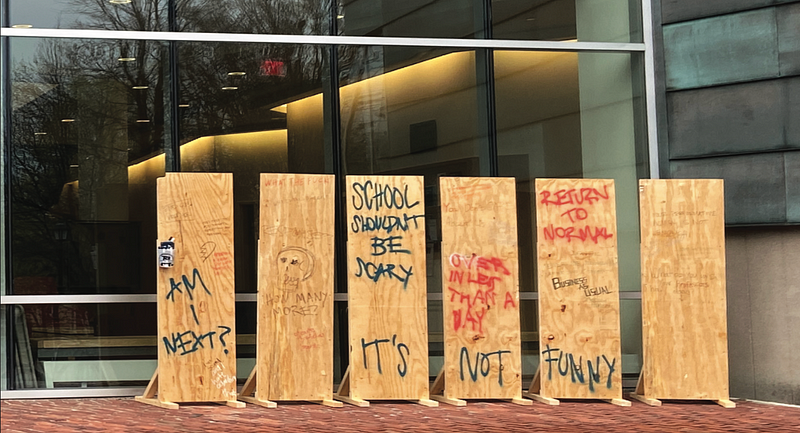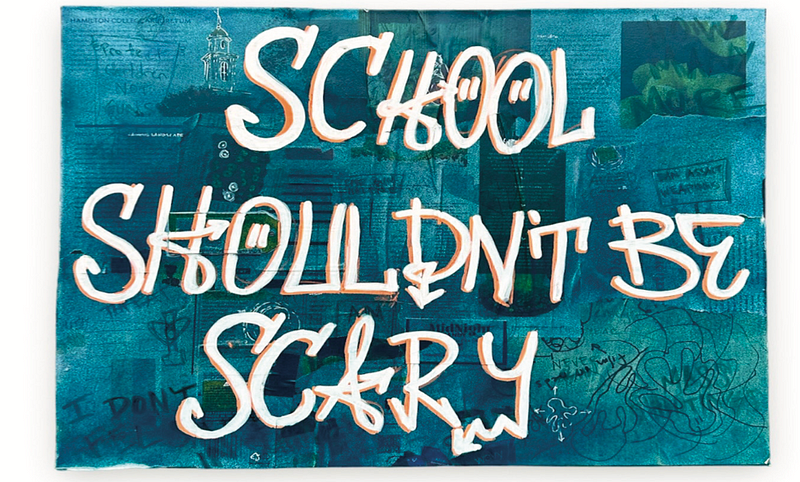by Meg Stroup ’26,
NEWS CONTRIBUTOR
In the aftermath of the shooting threat made on Jodel on April 16, Hamilton students have come together to create art displays with the hope of promoting dialogue in the community. Dani Bernstein ’24, an art major from outside of Boston, and co-creator Freya Langenberg ’24 have developed an artistic centerpiece for conversations regarding the threat with the erection of wooden boards at KJ’s main entrance, including a painting that has since been removed. When asked about what piqued their interest in art, Bernstein ex- plained, “I started making art as a little kid but have found it to be a release and a therapeutic experience. Over time I got really into paint- ing in high school when it was kind of like a safe place for me to think about things and engage with ideas.”

Dani Bernstein ’24 and Freya Langenberg ’24 created an art piece consisting of six wooden boards with student messages that stands outside the main entrance of KJ. Photo by Deanna Durben.
Bernstein has since carried his passion for art onto campus in the form of social activism and a method of providing visibility for the student body. “I hope that my art increases trans representation, and makes both Hamilton and the world kind of more friendly, loving, present places,” said Bernstein. Regarding the recent events, Bernstein continued to carry the message about this very sensitive topic, as he and his collaborators “wanted to create both a place of communal healing and an oppor- tunity for people to share their voices and be in the community and engage and reflect on these events together.”
Bernstein emphasized the importance of facilitating conversations about how violent threats affect individuals, as they believe the administration has not thoroughly addressed the impacts on the community, pointing to the administration’s “lack of a response, or men- tal health accommodations.” Specifically, the Student Assembly sent a request to adminis- trators proposing the cancellation of classes on the Monday and Tuesday after the threat to give students a couple of days to mental- ly process and recuperate, but this request was denied. Regarding the administration’s response, Bernstein brought up the value in “normalizing that people have feelings and re- actions and all sorts of thoughts surrounding the piece and what happened, so we wanted to validate all of those thoughts and create con- versation around it in the way that we felt that the school should have been supporting but really was not.”
As you walk by the entrance of KJ, you see six wooden boards with various messages, written in graffiti-esque text, including “Am I next?”, “School shouldn’t be scary,” and “It’s not funny,” along with countless smaller messages written by students. Bernstein explained the purpose of such a large and noticeable piece. “I originally put up a little painting that was taken and so in response to that we decided to do something bigger than kind of couldn’t be moved or stolen.”

Dani Bernstein ’24 crafted the public piece ‘school shouldn’t be scary’ (24x20in). In an Instagram post on April 16, he encouraged students to add their work or reflections outside KJ. Photo courtesy of Dani Bernstein.
The original painting, which displayed the message “School shouldn’t be scary,” was taken down by a Hamilton archivist with the purpose of preservation, according to Bernstein.
Bernstein explained his reaction to the painting’s disappearance, saying, “while I don’t blame him and I understand where he was coming from, and understand why he did what he did, it feels like to me a physical reflection of larger metadynamics going on where the school is taking our labor, emotion- al and affective labor, which we are all doing for free. We as students are giving this work and the school is using it for promotional ma- terial out of context.”
Bernstein gave a shout out to Lengen- berg, his collaborator who spent nothing short of two full days helping to create and build these pieces. He also wanted to acknowledge that “we don’t feel a particular sense of own- ership over the piece but kind of hope that it has developed its own meaning and that everybody on campus that was affected by those events can feel a sense of ownership around it and that it can help educate members of our community.”
Bernstein plans to continue to use art as a tool to express student experiences and hold the administration accountable. They mentioned future plans for campus, saying, “We are hoping to move towards a lot more public work in the next year or so regarding experiences like this and experiences with being queer on campus and with inadequate mental health support, and kind of pieces around all of those issues.”